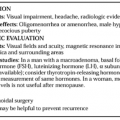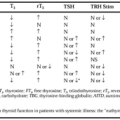THYROID LYMPHOMA
Part of “CHAPTER 41 – UNUSUAL THYROID CANCERS“
Classically, primary thyroid lymphomas occur in patients with Hashimoto thyroiditis and are usually non-Hodgkin B-cell lymphomas. Lymphomas include the “small cell” anaplastic carcinoma that has been determined to represent a small B-cell lymphoma.
DEMOGRAPHICS AND PATHOGENESIS
As previously noted, thyroid lymphoma generally occurs in patients with Hashimoto thyroiditis. Therefore, this malignancy is more common in women. It typically occurs in the fifth and sixth decades of life, but patients younger than 40 years have been reported.23,49,50 Nearly all patients have histologic evidence of Hashimoto thyroiditis and approximately two-thirds have detectable serum levels of antithyroid peroxidase or antithyroglobulin antibodies. Most patients are euthyroid at the time of diagnosis, although hypothyroidism is common. Primary thyroid lymphomas account for only a small percentage of lymphomas or thyroid cancers, but the tumors tend to respond well to appropriate therapy; thus, early and accurate diagnosis is critical.
The pathogenesis of thyroid lymphoma is unclear. The association with thyroiditis has given rise to the hypothesis that thyroid lymphoma may be a variety of MALT (mucosa-associated lymphoid tissue) lymphomas. The cells of MALT lymphomas typically resemble cells that surround lymphoid follicles (centrocyte-like); they can undergo plasmacytic change—as has been described in thyroid lymphomas51– and can progress to high-grade lymphoma. Thyroid lymphomas are comprised of a population of monotonous lymphoid cells that replace the thyroid parenchyma, with additional evidence of prior Hashimoto thyroiditis.
Stay updated, free articles. Join our Telegram channel

Full access? Get Clinical Tree





